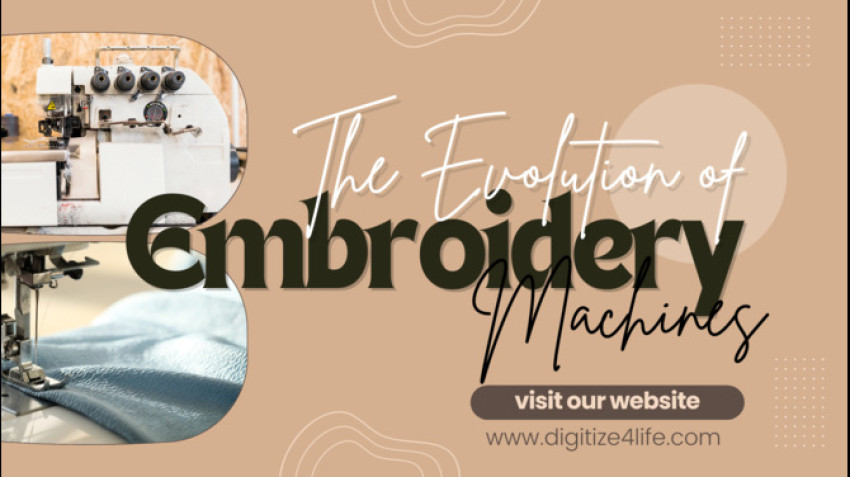
Embroidery is an ancient art form that has been used to decorate fabrics and garments for thousands of years across many cultures. From colorful peasant blouses to royal gowns studded with jewels, embroidery adds beauty, meaning, and value to clothing.
While embroidery was originally done completely by hand using simple tools like needles and thread, the invention of sewing machines in the 1800s paved the way for embroidery to become automated. The first embroidery machines enabled more intricate designs to be sewn faster and with greater consistency than human hands alone could accomplish.
Today, computerized embroidery machines are sophisticated tools that can produce complex designs with multiple colors and stitch techniques. The evolution of embroidery equipment has allowed home sewists, crafters, and businesses to create embellished masterpieces that would have been difficult or impossible just a century ago.
Early History
Hand embroidery dates back thousands of years, with some of the earliest examples found in China, India, ancient Egypt, and medieval Europe. Embroidery was an important part of many ancient cultures, used to decorate clothing, home furnishings, and religious artifacts.
In China, silk embroidery was practiced as early as the Shang Dynasty in the 14th century BC. Some of the earliest Chinese embroidery focused on cosmic themes, mythical creatures, and symbolic imagery. By the Han Dynasty (206 BC to 220 AD), embroidery had become extremely sophisticated and prized as an art. The development of silk helped Chinese artisans create delicate and detailed embroidery work.
Ancient Egyptian embroidery dates back to around 2400 BC. Extant examples showcase complex pictorial scenes rather than purely decorative motifs. Embroidery was used to decorate the clothing of royals and elites. It signified social status, with finer stitches being associated with higher rank. Egyptian embroiderers used linen threads in bright colors like red, blue, and yellow.
Hand embroidery was also prevalent in ancient India. Some of the earliest examples come from the Indus River Valley civilization around 2500 BC. Embroidered shawls found in Mohenjo-daro feature delicate needlework and demonstrate a high level of technical skill. Traditional Indian embroidery draws from a rich iconography of flowers, animals, and geometric patterns. Distinct regional embroidery styles emerged across the subcontinent.
In medieval Europe, hand embroidery flourished as an important decorative art. It adorned ecclesiastical vestments, altar cloths, furnishings, and the clothing of nobility. Fine embroidery signaled prestige, wealth, and status. Opus Anglicanum or “English work” was famous for its exquisite embroidery in silk and metal threads.
First Sewing Machines
The first sewing machines were invented in the early 1800s and paved the way for the development of embroidery machines. In 1790, the English inventor Thomas Saint created one of the first sewing machine designs, though it was never actually constructed.
In 1830, French tailor Barthélemy Thimonnier patented the first practical sewing machine to use a chain stitch. Thimonnier’s machine sewed straight seams for clothing and revolutionized garment production. However, riots from French tailors who feared unemployment from the machines led to the destruction of his factory.
The first lockstitch sewing machine was invented by American Walter Hunt in 1832-1834. Hunt’s machine used an eye-pointed needle and a second thread to create the lockstitch, but he neglected to patent it at the time.
In 1845, American Elias Howe patented the first high-functioning lockstitch sewing machine that was constructed and used commercially. Howe’s machine used two separate threads, a curved needle with an eye at the point, and a shuttle to pass the thread through the cloth. His key innovation was the needle’s eye at the point rather than the middle.
The sewing machine was further improved by American inventor Isaac Singer in 1851, who added ball bearings and improved the mechanism. Singer’s machine became immensely popular and was the first practical heavy-duty machine meant for major manufacturing rather than simply individuals.
Early Embroidery Machines
The first patented embroidery machine was invented in France by Josue Heilmann in 1828. Heilmann was inspired by the Jacquard loom and its ability to weave complex textile patterns automatically. His embroidery machine used punched cards like the ones used in Jacquard looms to guide the needle and create embroidery designs.
In the 1860s, William Newton Wilson of London patented the first machine that could stitch cursive monograms and names. This technology was further advanced in the 1870s by brothers Lyman and Cornelius Knapp, who patented new mechanisms on their embroidery machine that allowed for embroidering any shape or outline. Their machine came with punch cards with pre-made designs. By using different cards, various patterns could be embroidered without re-programming the machine.
The real breakthrough came in 1872 when Isaac Groebli of Switzerland patented a new kind of shuttle hook for embroidery machines. This provided the framework for commercial embroidery on a much wider scale, as multiple needles could operate on large machines simultaneously to mass-produce embroidery.
In the late 1800s, commercial embroidery took off, with large factories of embroidery machines running in Europe and the United States. What started off as just a way to mimic hand embroidery had evolved into a completely mechanized process that opened up embroidery to the public on a huge scale.
Computerized Embroidery
The embroidery machine industry took a major leap forward in the 1980s with the introduction of computerized embroidery machines. These machines used punch cards or floppy disks to digitally store embroidery designs that could then be stitched out automatically. This opened up an exciting world of possibilities, allowing for more precision, consistency, and complexity in embroidery.
Whereas earlier mechanical embroidery machines relied on Cam mechanisms to move the hoop, computerized machines used stepper motors for precise positioning. This enabled them to follow digitized design files and accurately reproduce embroidery motifs. The punch card or floppy disk contained the stitch positioning data, which acted as instructions for the stepper motors.
Modern Home Machines
The popularity of home embroidery machines has exploded in recent years. Advances in technology have made these machines affordable, user-friendly, and capable of professional quality embroidery right in your own home.
Whereas early home embroidery machines were limited to simple designs and poor stitch quality, modern machines can stitch out intricate designs with stunning detail. Built-in computers and LCD touch screens make it easy to edit designs, adjust colors, and get the perfect placement.
Features like automatic thread trimmers, multiple hoops and frames, and embroidery editing software are now standard. Wireless connectivity allows you to download designs and update machine software without cables. Automatic thread tension and presser foot pressure take the guesswork out of setup.
Modern embroidery machines range from inexpensive starter models under $500 to advanced multi-need professional machines costing several thousand dollars. Most hobbyists opt for a mid-range model in the $800 to $1500 range which offers versatility for both embroidery and regular sewing.
With a home embroidery machine, crafters and home decorating enthusiasts can add a personal touch to clothing, hats, towels, bags, quilts, and more. It’s an accessible craft that allows you to embellish your projects with custom monograms, names, motifs, and unique designs. The embroidery possibilities are endless.
Industrial Machines
Industrial embroidery machines are designed for large-scale commercial production and maximum efficiency. Unlike home embroidery machines, industrial machines are faster, more durable, and capable of embroidering much larger areas.
The biggest difference between industrial and home embroidery machines is speed. Industrial machines can stitch at speeds from 700 to 1500 stitches per minute. This allows companies to produce embroidered items much faster. Some industrial machines have multiple heads, allowing them to work on multiple products at once. For example, a 15-head embroidery machine can embroider 15 shirts simultaneously.
Industrial embroidery machines have much larger embroidery fields than home machines. The embroidery field is the maximum hoop size the machine can accommodate. Home embroidery machine hoops are usually 6×10 inches to 8×12 inches. Industrial machines can embroider fields from 16×20 inches up to 28×40 inches. This expanded area allows them to embroider large designs, jacket backs, sheets, and other oversized items impossible on a home machine.
These machines are built for durability, capable of running 24/7 in production environments. They use heavy-duty parts including industrial-grade needles, motors, and internal components. Most industrial embroidery machines come with a variety of convenient features for commercial work, like automatic thread trimmers, auto oiling systems, large thread capacities, and enhanced computer connectivity.
Advanced capabilities of industrial embroidery machines include specialized techniques like 3D puff embroidery, sequin embroidery, chenille embroidery, applique, and more. The computerized software allows for editing and customization of designs as well as integration with other equipment. Overall, industrial embroidery machines offer power, speed, reliability and versatility for professional embroidery work.
Embroidery Machine Software
One of the biggest evolutions in embroidery has been in design software. Early embroidery machines only allowed stitching preset designs. To stitch a new design, it had to be digitized on a computer with CAD-like software and transferred to the machine via a memory card or cable.
The first home computerized embroidery machines in the late 1980s and early 1990s came with limited built-in design capabilities. Users could edit preset designs and create simple lettering and shapes.
In the mid-1990s, more advanced design software emerged for home computers. Programs like Amazing Designs allowed home embroiderers to digitize images into stitches with various tools and effects.
Today’s embroidery software provides sophisticated editing tools like stitch splitting, color sorting, stitch angle changes, object transforms and combining designs. Popular programs used with home and industrial machines include Artista, Bernina Embroidery Software, Brother PE-Design, Husqvarna Viking Embroidery Software, Janome DigitizerMB, Pulse Ambassador and more.
The Future
The future of embroidery machines looks bright as the technology continues to advance rapidly. Here are some predictions for where embroidery technology is heading:
– Higher resolution and more detail – Machines will be able to produce embroidery with increasing detail and dimension, mimicking the look of hand embroidery even more closely.
– Faster speeds – Industrial machines are already extremely fast, but home models will catch up, allowing embroiderers to complete projects more quickly.
– Wider embroidery fields – The size of the embroidery field will expand, allowing for bigger and more complex designs to be stitched out in one hooping.
– More connectivity and digitization – Machines will become more connected to external software and the cloud, improving digitizing capabilities directly on the machine.
– Increased automation – With improving AI and computer vision, machines may take on more steps of the embroidery process with less human intervention needed.
– Specialty techniques – Machines will master specialized techniques like lace making, applique, quilting, and other effects.
– Customization – On-demand customization and personalization will be easier than ever.
– Lower costs – Improved manufacturing and competition will continue to lower prices and make advanced features more accessible.
– User-friendly features – Better display screens, tutorials, troubleshooting and more intuitive controls will allow new users to get up to speed quickly.
– More versatile uses – Embroidery will expand beyond just fabric into gifts, paper crafts, home decor, leather, and more.
While embroidery started out as an artisan craft, machines have allowed it to become a popular hobby and industry. As technology progresses, embroidery will reach new heights in artistry and application. Both professionals and home embroiderers have an exciting future ahead with more possibilities than ever.
Conclusion
The history of embroidery machines has been a progression from basic hand-operated tools to computerized industrial machines and everything in between. From the first sewing machines adapted to create simple stitches in the 1800s to the programmable home embroidery machines of today, the capabilities and convenience have vastly improved.
The development of computerized embroidery took the craft to a new level, enabling multi-color designs and precision stitching. While industrial machines continue pushing the boundaries of speed and capabilities, home embroidery machines now offer hobbyists and small business owners the chance to embellish garments and crafts with detailed embroidery designs at the touch of a button.




